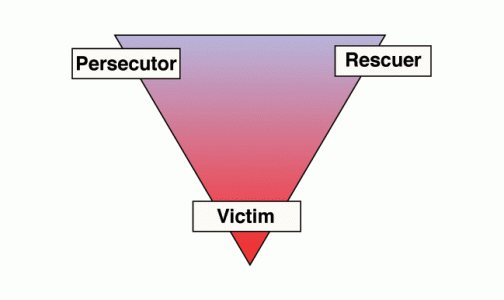Part 1 introduced the dynamics of the Karpman Drama triangle in relationships. It explored how the power struggles and dynamics of victim, perpetrator, and rescuer can keep you caught in a toxic dance with your partner.
Now, we’ll turn to focus on creating change in your relationship through jumping off the Karpman triangle into a healthier way of relating. Each of the three roles of the triangle has an alternative counterpart that allows you to experience freedom from the dysfunctional dance of power in the drama triangle. These three parts must be experienced in the order that follows.
Taking Responsibility
The counterpart to the victim role is taking responsibility for the adult self and approaching yourself with kindness, empathy, and courage. This is the most important step: the following two steps cannot be achieved without completing this step first.
Taking responsibility requires getting in touch with the part of you that feels like a victim. Typically this part of you feels young, like a child version of yourself. Often this is because the victim role reacts to your unmet needs or desires from childhood. Working through these unmet needs in therapy can help you understand why you react so strongly to situations in your present-day life. Therapy will help you learn to establish self-care routines and healthy communication in relationships to soften these strong reactions.
Our reactions to distressing situations relate to coping mechanisms or survival instincts picked up in childhood that we now repeat as a way of protecting ourselves. Those old patterns often don’t work in the way that they used to, yet we go back to them because they are familiar.
As an adult, you no longer have to be beholden to these patterns of coping. You can choose a new way of living instead of just surviving, which is what taking responsibility is all about. It involves reminding yourself that, as an adult, you can make different choices. Oftentimes as children we felt powerless. This step is a way to reclaim a sense of power and self-assurance to work for what you want instead of feeling powerless.
Come up with a mantra or statement that embodies a different way of viewing yourself. For example, in the victim role, you might see yourself as unlovable or worthless. Instead, in taking responsibility, you’ll acknowledge and own the reality that you are lovable and of great worth. As you acknowledge these realities, you’ll notice the fog of shame lifts and you’ll be able to see your path out of the drama triangle more clearly.
Examining Options
Once you’ve taken responsibility by acknowledging the impact of past wounds and your capabilities and power as an adult, you can then move into examining the options in front of you. This counterpart to the perpetrator role is a healthier way of coping with feeling trapped in the victim role.
After acknowledging your adult capabilities, make yourself a list of all the different options in front of you. Remember in this list that you are only in control of yourself: your actions, thoughts, attitudes, and responses to emotions. You cannot control other people. When your choice hinges on the actions of someone else, this is a setup to get caught up in the drama triangle again. Instead, look at what you have control over and what changes you can make.
Brainstorm in this step: write down everything you can possibly think of for different options, even if they seem “out there” or impossible. If you’re doing this with someone else, such as your spouse, know that you don’t have to agree 100% on these: you’re just getting ideas on the table. Once you’ve brainstormed several ideas, you might notice a cohesive theme starting to form that will lead you toward the next step.
One important note: if you find yourself feeling like a victim again or re-entering the drama triangle, notice this and know that it is normal to slip back into old patterns. Pause and go back to the core of the victim role you identified earlier and repeat the process of taking responsibility for yourself.
Negotiate to Make a Choice
Once all your options are laid out, you’re prepared to make a choice with the knowledge in front of you. Rather than attempting to take on the world through the rescuer role, negotiating requires inviting relationship and enlisting the help of others. Identify which of your options is the best possible outcome with all the information you’ve gathered. Make a plan on how to implement this choice. Take an action step as soon as possible to get this choice moving so that you don’t forget and slip into old patterns.
This choice will likely involve some difficulty or change in your life, and you may be tempted to jump back onto the drama triangle to return to something that feels familiar. Remind yourself of your vision for ending the drama of feeling trapped and the experience of the victim role. You may have to learn to set boundaries or ask for what you need more readily, but the hard work will be worth it.






